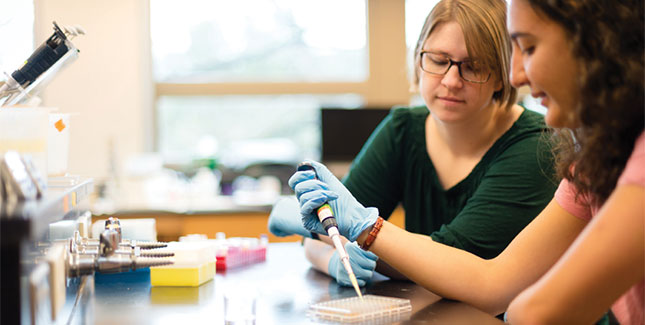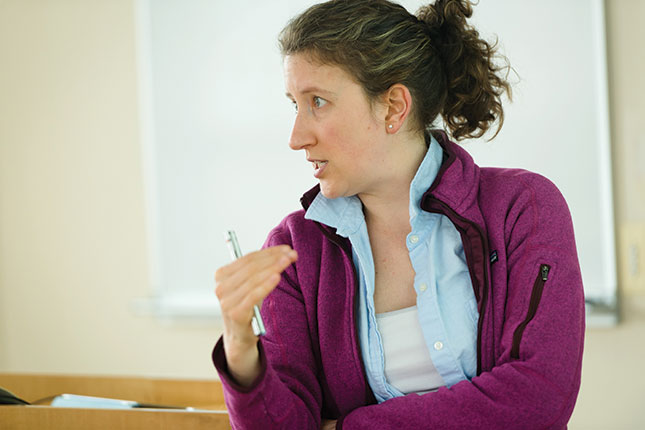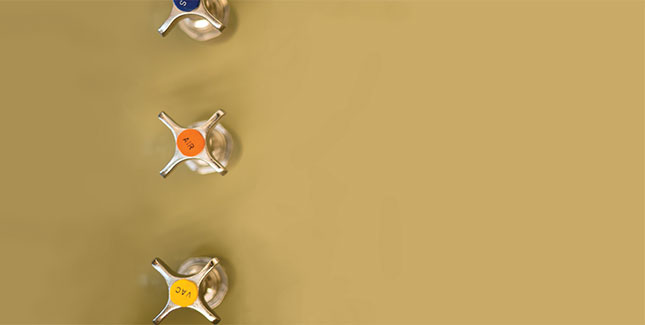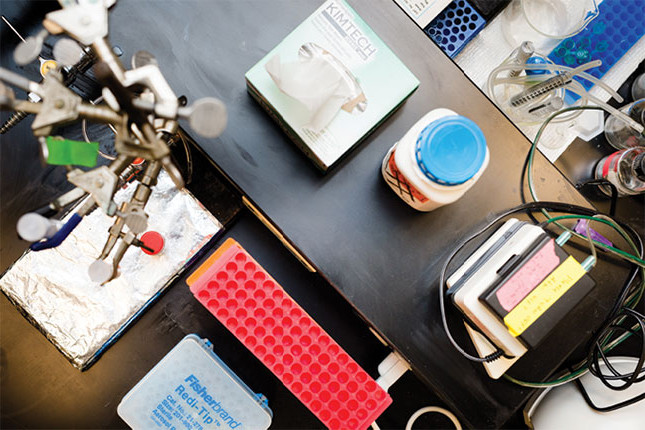A Winning Formula
Educating top chemists, professors, inventors, and researchers through a forward-thinking chemistry program rooted in history
It’s 11:30 a.m. on the Tuesday after spring break, and twenty-three students have settled in Chem 212: Chemistry of Biomolecules class in Kendade 303. After some housekeeping items and a syllabus update, Professor Katie McMenimen ’03 launches into an exacting seventy-five-minute lecture. The material is dense, supported by formulas and graphics displayed on a screen in the front of the classroom. Students take notes furiously. There are frequent questions, and with each new query, McMenimen pauses. She wants her answers to have precision, to offer ample information—but not to overwhelm.
Chem 212, designed for non-biochemistry majors, offers an introduction to basic biochemical principles. One of four required electives in the biochemistry discipline, the course is broad rather than deep as it must meet the varying needs of chemistry, biology, and post-baccalaureate students who are all on different academic and career paths. Nearly half of the thirty-seven students who take Chem 212 each semester will head to graduate schools such as Northwestern, California Institute of Technology, or Harvard for doctoral degrees, while others will enroll at medical schools, and still others will serve as research technicians or teach at the high school level. “There’s quite a bit of ground that students want covered,” says McMenimen, “but they don’t necessarily need a whole course on every individual piece.”
So McMenimen is concise in her lecture. She moves quickly and deftly through the demanding lesson, and she directs students to the textbook if they want or need to learn more to suit their purposes. “It’s entirely a balancing act,” she says. “Students get to take the individual bits and, with knowledge from other classes, synthesize it together to help them understand the material.”
In fact, the entire rigorous chemistry curriculum at Mount Holyoke is a balancing act, as professors strive to provide relevant information in an industry that is constantly on the brink of discovery as well as prepare students for careers that may not yet exist.
Tradition and Prestige
Mount Holyoke has a long history of national excellence in educating women in chemistry—and in the physical and life sciences in general. That history began with founder Mary Lyon, who was herself a chemist, and continued with faculty icons such as Emma Carr, class of 1902, and Lucy Pickett, class of 1925. These esteemed chemists each taught at the College for more than thirty-five years and were both acclaimed worldwide for their advances in the field. In addition, they each received the prestigious Francis P. Garvan Medal, granted by the American Chemical Society for distinguished service by women chemists.
“Pickett and Carr really pioneered getting undergraduates involved in research and publishing papers,” says Maria Alexandra Gomez, professor and chemistry department chair, who also notes it’s the chemistry department’s definitive research culture that gives this small, liberal arts college a competitive edge over big research universities. “The biggest help to our students is being able to join a research group and work directly with a principal investigator,” Gomez says. “When an undergrad goes to a large research university, she gets assigned to a grad student and doesn’t work directly with a principal.”
“I think being a chemistry student at Mount Holyoke has gotten more exciting over time,” Gomez says. “The level and amount of instrumentation that’s available to undergraduates is really quite impressive.”
“There’s quite a bit of ground that students want covered.”
Professor Katie McMenimen ’03
Facilities and Resources
The chemistry department is one of eight campus departments housed in Kendade Hall, a 40,000-square-foot building completed in 2003 that connects existing Carr and Clapp laboratories and Shattuck and Cleveland Halls to form a unified science center. Gomez says one quarter of the College’s students major in either the sciences or mathematics—twice the number of women majoring in these areas at comparable coeducational institutions.
Gomez says the College has recently acquired more state-of-the-art equipment than it has ever had, making the department even stronger. The College now boasts an atomic force microscope that affords students a view of materials at the atomic level.
“You can see at the atomic scale,” Gomez says, noting the equipment is used by students to study the surfaces of various materials—such as polymers. The same technology is used for developing surface materials used in hip replacements and high-tech sports equipment.
In fall 2013, nine spectrophotometers—devices used to measure the amount of light an object absorbs—were purchased through a $150,000 grant from the George I. Alden Trust, setting the department ahead of many peer schools in terms of instrumentation resources and crucial opportunities for students to learn and apply quantitative analysis skills.
Thanks to a 2011 $500,000 grant from the Andrew W. Mellon Foundation, chemistry students are also involved in a cross-disciplinary project for the Mount Holyoke College Art Museum, in which students use modified digital cameras—with infrared lenses—to study the under-layers of paintings in the museum; their findings include a forged signature on a painting by William Louis Sontag as well as images that have been painted over in the final renditions of other works.
The Undergraduate Experience
While not all chemistry majors come to Mount Holyoke knowing they’ll pursue study in chemistry, many applicants are attracted to the school precisely because of its strong recognition in the sciences.
Rachael Mazzamurro ’15, a twenty-one-year-old with a bachelor’s degree in neuroscience and behavior, who headed to Dartmouth Medical School in August, chose Mount Holyoke over Smith and Brandeis, in part because of the College’s exceptional faculty and its reputation in the sciences. Mazzamurro has always wanted to pursue a career in medicine, and she enrolled in Chem 212 because it’s a prerequisite required by Dartmouth, where she will spend the next four of her roughly nine to twelve additional years of study. Mazzamurro says she’s proud that women hold powerful positions on campus. And she finds it empowering that the College teaches young women that they can excel in the sciences and in other fields traditionally dominated by men.
Arda Kotikian ’15 also recognized her interest in science and engineering early on. As a child she built treasures from trash, such as shoes she fashioned from scraps of cardboard. “I like playing with things,” she says, noting that she hopes to be an inventor one day. Kotikian graduated with a double major in math and chemistry and this fall began work on a doctorate in materials science and mechanical engineering at Harvard’s School of Engineering and Applied Sciences. In summer 2014, Kotikian completed a Lynk-funded internship at Harvard, where she was tasked with developing materials to be used in 3-D printing processes and with creating materials that are used to monitor heart tissue contractions. She loved the creativity behind the labor.
And although she is more than a decade removed from her own Mount Holyoke student experiences, Smith College chemistry professor Mohini (Sridharan) Kulp ’00 shares many of the same experiences of today’s undergraduates. Kulp grew up mostly in Nairobi, Kenya, where children are educated in a specialty area, or track. Kulp was on the science track in high school; and she chose Mount Holyoke, where she earned a bachelor’s in math and biochemistry, “because I had the sense that if you wanted to be a scientist, this was the place to be in the US.”
She was right. The rigor of the College combined with a broad range of opportunities, which included a year spent at Dartmouth College, prepared her for graduate school and her career. But it was a Howard Hughes Summer Fellowship, a research project Kulp completed early on with Professor Sean Decatur, a protein biochemist, that was most influential. The project fueled a passion for research that has yet to wane and morphed into a demanding, fulfilling three-year project with Decatur. “I wasn’t just shadowing a graduate student,” she explains. “It was my data, and I had to understand it.”
“The chem department was very formative,” adds Kulp, who holds a doctorate in biophysics from the University of California, San Francisco. “It really set me up well for doing graduate work. Having to pre-sent (my undergraduate thesis) at the undergraduate research symposium and present in front of peers and professors really helped me. It still helps me today.”
Beyond the Classroom
Biochemistry lecturer Tim Miles leads the Chem 212 lab that meets six times throughout the semester to supplement classroom work. During one particular session, Mazzamurro, Kotikian and Emilie Heidel ’10, a post-baccalaureate premed student in her third year, were part of a group working to bring a semester-long project to a close. Kotikian and Heidel, paired at a lab station at the end of the room, talked quietly about their individual roles in the experiment. They were surrounded by beakers, syringes, experiments in various stages, and state-of-the-art equipment, like one of the newer spectrophotometers.
Heidel says the knowledge she gained through her lab work will be useful to her in medical school and beyond. It can, for instance, be applied to the work of studying diseases and the development of new treatments.
In addition to learning critical laboratory skills as they worked with partners, Kotikian and Heidel also bonded and developed their “people skills,” as Kotikian says. In fact, in each of their respective departments, they have formed deep connections with peers and with professors, in and outside of the classroom.
“The main point is to get everyone together and build connections.” Arda Kotikan ’15
Extracurricular offerings support this outcome. In addition to chemistry socials that are held at the end of each semester, the department also offers biweekly luncheons, during which students compare notes on topics ranging from how to write a research paper for a fellowship application to how to email a professor, a topic often raised by first-years students.
In addition, lectures organized by the department are also held weekly, with speakers covering a broad range of topics. The annual Lucy Pickett Lecture is a major draw. This year, nearly fifty students attended a presentation by Polly Arnold, Crum Brown Chair of Chemistry at the University of Edinburgh, Scotland, who champions women in chemistry and in sciences in general. Professor McMenimen says students had so many questions for Arnold that the lively dialogue continued over dinner across the street at Food 101, and Arnold had questions of her own. “She was interested in the students and what they’re learning and what they’re interested in,” McMenimen says.
Kotikian, who attended the lecture, says such events build community at the College. “The main point is to get everyone together and build connections,” she says, noting the result is a tight-knit department in which students study together and professors and students connect. “They show they care about you,” she says.
McMenimen says the interpersonal scene has not changed since she was a student, nor has the rigor and the push for learning through seminar experiences. “That’s been a very consistent part of the department culture. . . . You really spend a good chunk of time with the students you are in class with,” she says. “I think that really formed a nice little family for me while I was a student.”
Continuing the Legacy
Building on the strong reputation of the department’s history, current chemistry faculty develop model curricula in cross-disciplinary areas, continuing to position Mount Holyoke at the top of its peers. Many of these professors have strong interdisciplinary interests, resulting in a culture in which faculty regularly collaborate on cross-disciplinary curricular initiatives and develop research projects that involve students from different departments.
The College’s new Engineering Nexus program is an example of this important focus. The program allows chemistry students to investigate chemical and materials engineering and also crosses department lines into physics, math, biology, and environmental sciences. Currently, Gomez says, ten students are enrolled in the Engineering Nexus; several are chemistry or biochemistry majors.
Inspired by a high school chemistry teacher, McMenimen was drawn to Mount Holyoke’s chemistry department by a visit to campus that included time with Professor Darren G. Hamilton. She later worked in Hamilton’s research lab as a student, and that work led to her desire to become a professor herself. Professors Hamilton and Donald Cotter, McMenimen’s advisor for several years, “pushed me to think outside the box,” she says, “and really let me take every opportunity I could to make the most of my experience in chemistry and at Mount Holyoke.”
Mary Lyon likewise strived for the best, and she persisted against all odds. In the three years she spent raising donations and awareness about her college for women, she endured ridicule from those who felt her ambitious undertaking would be “wasted” on women. But her work has been continued by generations of young scientists and the faculty who have led them, and the College continues to be recognized for its strength in the sciences. A 2009 National Science Foundation study notes that Mount Holyoke ranked sixth among all selective liberal arts colleges in producing women who received doctorates in the life sciences from 1966 to 2006. During the same period, the College ranked first in graduating minority women who received US doctorates in the physical and life sciences. And as part of the largest class of graduates embarking on life outside the College’s gates, Mazzamurro, Kotikian, and their sisters in the class of 2015 are the next in a long line of women to continue the work that sustained them in the classrooms and labs of their undergraduate days.
—By Janice Beetle
Janice Beetle is a writer and communications professional in the Pioneer Valley and the owner of Beetle Press.
—Photography by Joshua Sugiyama
This article appeared in the summer 2015 issue of the Alumnae Quarterly.
July 12, 2015














A fabulous college to study chemistry, hands on! Nostalgic about the enthusiasm of Sheila Browne and the erudition of Jan smith. A class apart!